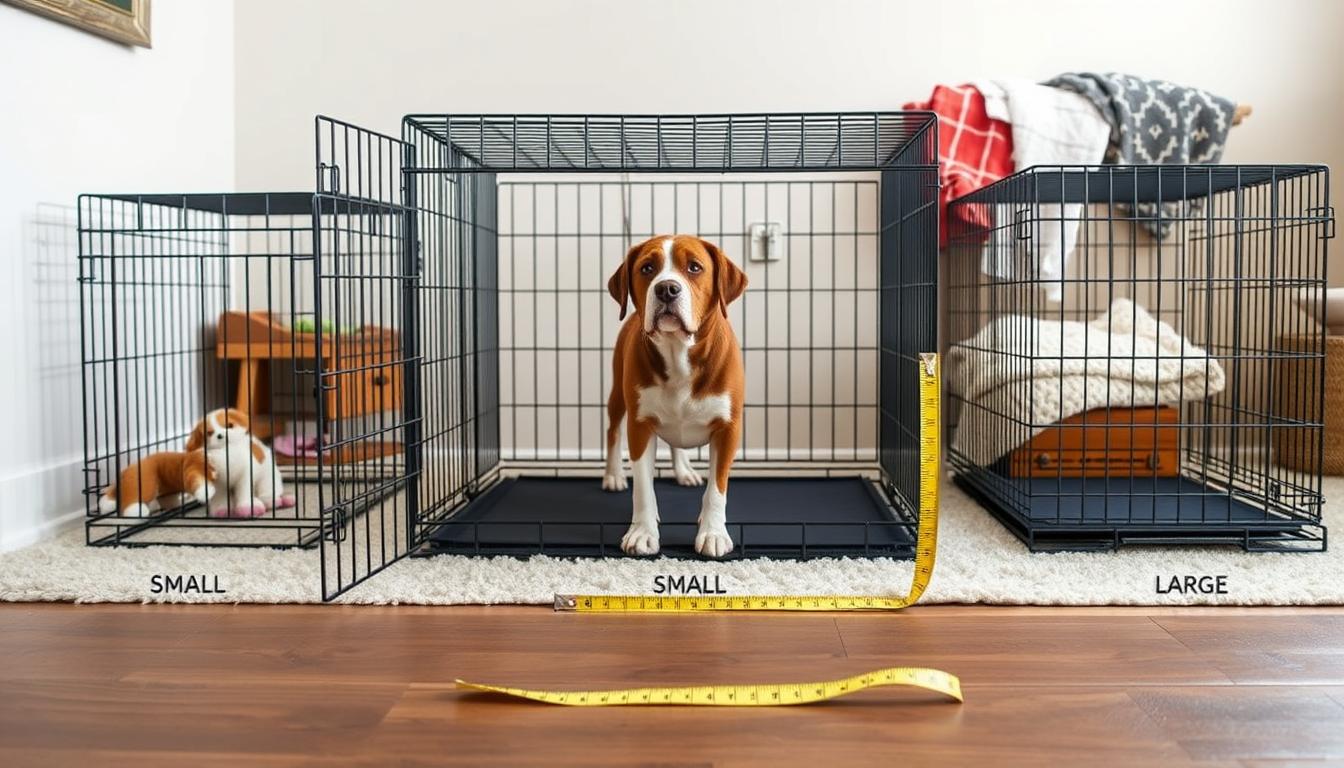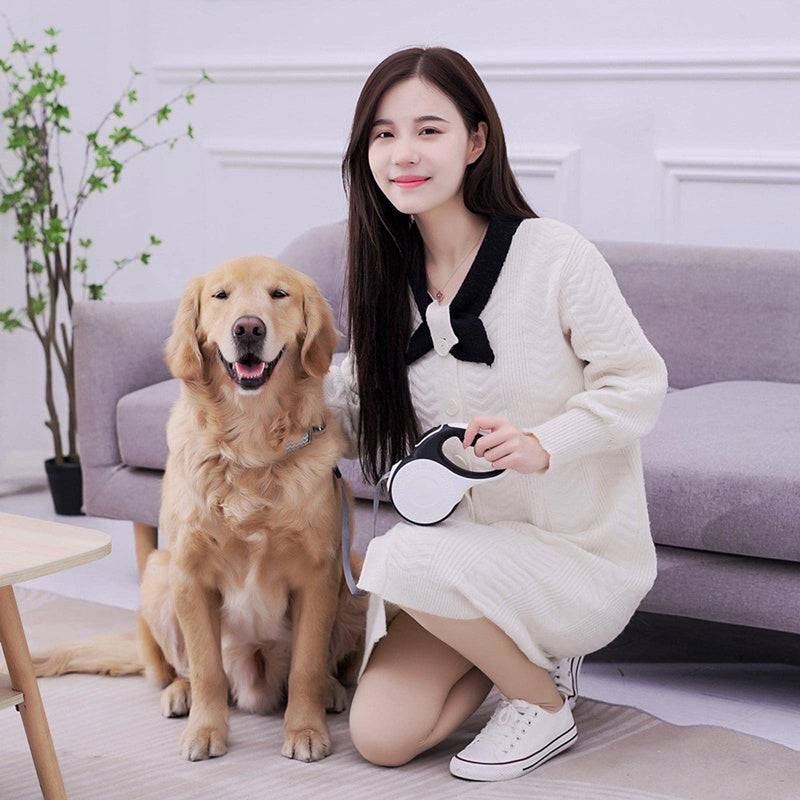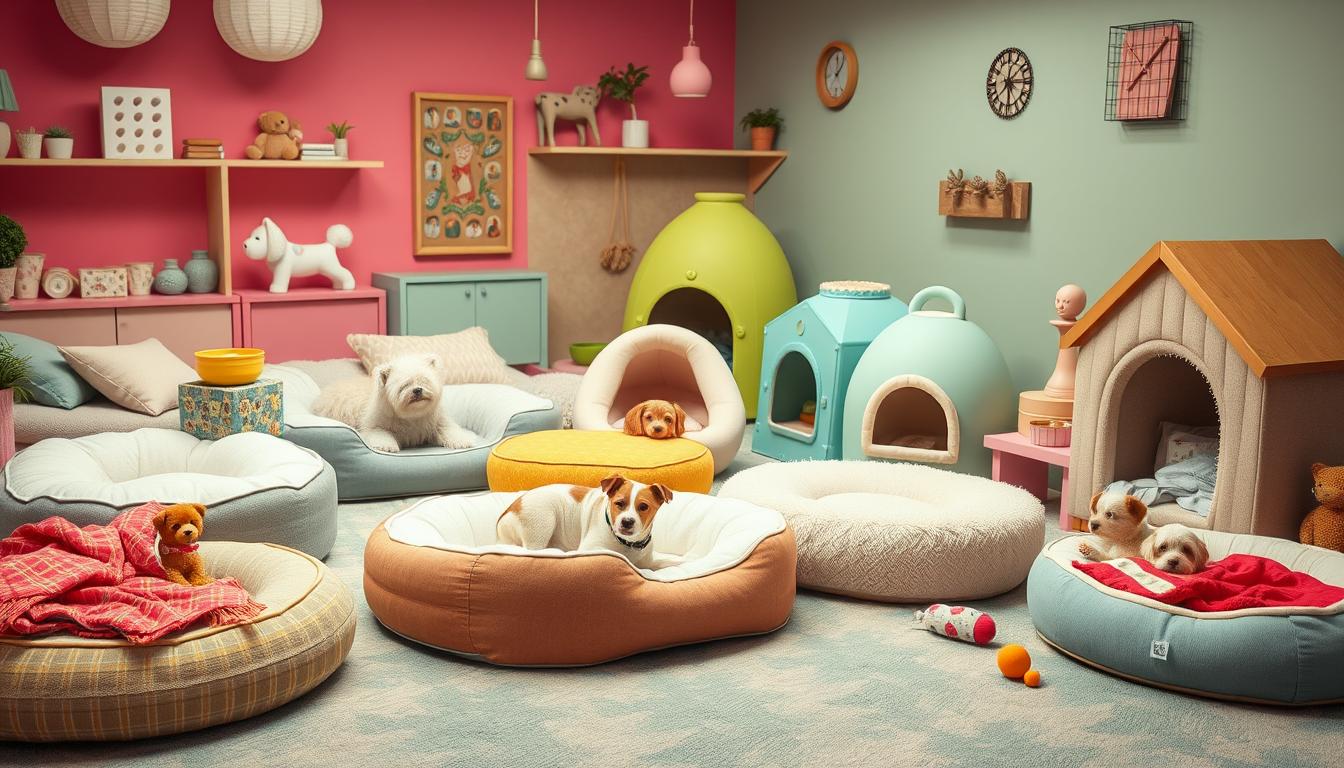
Pet Litter Tray
If you're a dog owner in Australia, you want the best for your pet. A dog crate is a must-have. It's a safe and cozy spot for your dog to rest and relax. It also helps with training and travel.
This guide is for both new and experienced dog owners. It will help you pick the right crate for your dog's safety and comfort. You'll learn about the crate's benefits, how to choose the right one, and how to make it comfy for your dog.
Key Takeaways
- Investing in a high-quality dog crate is essential for your dog's safety and comfort.
- A dog crate can help with training and travel, making it a valuable tool for any dog owner.
- Choosing the right size dog crate is crucial to ensure your dog's comfort and security.
- A dog crate can provide a sense of security and comfort for your pet, reducing anxiety and stress.
- With the right dog crate, you can create a safe and cozy space for your dog to rest and relax.
- A dog crate is a long-term investment in your dog's health and happiness.
- By following this guide, you can make informed decisions and choose the best dog crate for your furry friend.
Understanding Dog Crates: Benefits and Purposes
As a dog owner, you want to give your pet a safe and comfy place. A dog crate can be a great solution. It offers crate benefits like a secure spot for your dog to relax and feel safe. This is especially good for dogs with anxiety or stress.
Crates also help with dog safety by keeping your pet out of harm's way. They can stop your dog from getting into toxic stuff or running off. Plus, a crate keeps your home and things safe when you're not watching.
Safety and Security Benefits
A crate is like a safe haven for your dog. It keeps them safe from dangers and stops accidents. It also stops your dog from doing things that could hurt them, like chewing or digging.
Natural Den Instincts
Dogs naturally want to den, and a crate lets them do that. It gives them a cozy, secure spot. This makes them feel more at ease and less stressed.
https://youtube.com/watch?v=hpDHViSXU6A
Travel and Transportation Advantages
Crates also make traveling with your dog safer and more comfy. They provide a secure, cozy spot for your dog to ride in. This makes the trip better for both you and your pet.
| Crate Benefits | Description |
|---|---|
| Provides a safe space | Protects your dog from potential dangers |
| Promotes dog safety | Prevents accidents and reduces the risk of injury |
| Enhances canine security | Prevents your dog from damaging your home or belongings |
Types of Dog Crates Available in Australia
In Australia, you can find many dog crates like wire, plastic, and soft-sided ones. Each has its own benefits and features. It's important to know the differences to pick the right one for your dog.
Wire crates are great for dogs that love to be around people. They offer good air flow and visibility. Plastic crates, however, are cozy and quiet. They're perfect for dogs that get anxious or need a calm spot.
Soft-sided crates are light and easy to carry. They're perfect for traveling with your dog. These crates are made to be strong and easy to set up, great for trips or visits.
Here are some key features to consider when choosing between wire crates, plastic crates, and soft-sided crates:
- Wire crates: durable, easy to clean, and provide excellent ventilation
- Plastic crates: cozy, quiet, and often more affordable than wire crates
- Soft-sided crates: lightweight, portable, and perfect for travel
Knowing the pros and cons of each crate helps you make a smart choice. You can pick the best crate for your dog and your lifestyle.
| Crate Type | Features | Benefits |
|---|---|---|
| Wire Crates | Durable, easy to clean, ventilated | Perfect for dogs that like to see their surroundings |
| Plastic Crates | Cozy, quiet, affordable | Ideal for dogs that feel anxious or need a quiet space |
| Soft-Sided Crates | Lightweight, portable, easy to set up | Great for travel, camping trips, or visits to friends and family |
Selecting the Right Size Dog Crate
Choosing the right dog crate is key. You need to make sure your dog has enough room to move around. To do this, take your dog's measurements. Measure their length, height, and width, then add a few inches for extra space.
For puppy crates, think about your puppy's future size. Puppies grow fast, so pick a crate that fits their adult size. A crate that's too small can be bad for your dog. But a crate that's too big might make them feel scared or unsure.
- Choose a crate that's made for your dog's breed or size.
- Look at the crate's material and how long it lasts.
- Think about how easy it is to move and use the crate.
By following these tips and measuring your dog accurately, you can find the best crate. A comfy and the right-sized crate is key for your dog's happiness.
Essential Features of a Quality Dog Crate
Choosing the right dog crate is key for your dog's safety and comfort. Look for secure latches to keep your dog safe. Also, a crate with removable trays makes cleaning easy, saving you time.
A sturdy crate can handle your dog's chewing and scratching. Some crates have divider panels for puppies or dogs that need to be separated. Wheels make it easy to move the crate around your home.
Here are the main features to look for in a quality dog crate:
- Secure latches to prevent escape
- Removable trays for easy cleaning
- Sturdy construction to withstand chewing and scratching
- Divider panels for separating dogs or puppies
- Wheels for easy mobility
By focusing on these features, you can find a crate that's safe and comfy for your dog. Always think about your dog's needs. Choose a crate that fits their size, breed, and age.
The right crate features can make your dog happy and healthy. Whether for training, travel, or a safe space, a good dog crate is a must-have for any dog owner.
Making Your Dog Crate Comfortable and Inviting
To make your dog's crate cozy, focus on crate comfort. Choose the right dog bedding for their crate. Options include plush mats, orthopedic beds, and heated beds for cold weather.
When picking a spot for the crate, make sure it's where your dog feels safe and loved. A quiet corner of your living room or near your bed is perfect. But, avoid places with lots of people or noise, as it can stress your dog.
Here are some tips to make your dog's crate comfy and welcoming:
- Provide enough air to prevent your dog from getting too hot
- Keep the crate out of direct sunlight and drafts
- Add a comfy bed or mat to the crate
- Place the crate in a quiet and safe spot
By following these tips, you can make a cozy and inviting space for your dog. Always put your dog's comfort and happiness first when setting up their crate.
Creating a cozy dog crate is key to your dog's happiness. Choose the right bedding, place the crate in a safe spot, and ensure good air flow. This way, you'll make a warm and welcoming space for your dog to relax and feel secure.
| Bedding Options | Benefits |
|---|---|
| Plush Mats | Soft and comfortable |
| Orthopedic Beds | Supportive and pressure-relieving |
| Heated Beds | Warm and cozy for colder climates |
Introducing Your Dog to Their New Crate
When introducing your dog to their new crate, it's key to make it a positive association. Use treats and toys to make the crate inviting. Place the crate in a common area, like the living room, and let your dog explore at their own pace.
A crate introduction should be slow and gentle. Start by leaving the crate door open, letting your dog come and go as they please. As they get more comfortable, close the door while you're there, giving treats and praise for calm behavior.
Success in crate introduction comes from gradual acclimation. Start with short times in the crate and slowly increase it. Always watch your dog's behavior and adjust as needed to avoid stress or discomfort.
- Be patient and consistent, as crate introduction can take time
- Use positive reinforcement techniques, such as treats and praise, to encourage good behavior
- Watch for signs of stress or discomfort, such as whining or pacing, and adjust the introduction process accordingly
| Crate Introduction Tips | Benefits |
|---|---|
| Gradual acclimation | Reduces stress and anxiety |
| Positive association | Creates a welcoming environment |
| Consistency | Helps establish a routine |
Crate Training Techniques and Timeline
Starting crate training requires patience and consistency. A good training plan helps you know what to expect. Begin by making the crate a welcoming place for your dog. Use treats and praise when they go in on their own.
Here are the steps for a training plan:
- Introduction to the crate (days 1-3)
- Gradual increase in crate time (days 4-7)
- Phasing out treats and praise (days 8-14)
Challenges like whining or not wanting to go in the crate can happen. Stay calm and keep training the same. Don't let your dog out when they whine. Wait for them to calm down before letting them out.
A typical training plan looks like this:
| Day | Activity | Duration |
|---|---|---|
| 1-3 | Introduction to crate | 5-10 minutes |
| 4-7 | Gradual increase in crate time | 30 minutes to 1 hour |
| 8-14 | Phasing out treats and praise | 1-2 hours |
By sticking to a plan and using positive methods, crate training will be a success. Stay patient, consistent, and positive. Your dog will learn to love their crate.
Safety Guidelines for Dog Crate Use
As a responsible dog owner, it's key to think about crate safety and how long your dog stays in it. The Australian weather can be very hot in summer and cold in winter. So, it's important to think about the weather when using a dog crate.
The usual rule is to keep your dog in their crate for no more than 8 hours if they're an adult. For puppies, it's 4-6 hours. But, this can change based on your dog's age, size, and what they need. It's also good to give them breaks and exercise to avoid stress from being in the crate.
Here are some tips for keeping your dog safe and comfy in the Australian weather:
- Make sure there's enough air and shade to stop your dog from getting too hot in summer.
- Choose a crate that keeps your dog warm in winter.
- Put the crate in a quiet, sheltered spot to help your dog feel less stressed.
By following these tips and thinking about the Australian weather, you can make sure your dog is safe and happy in their crate. Always put your dog's safety first and adjust how long they're in the crate based on what they need.
For more advice on crate safety and how long, talk to your vet or a dog trainer. They can help figure out the best crate use for your dog.
| Dog Age | Maximum Crate Duration |
|---|---|
| Puppies (under 6 months) | 4-6 hours |
| Adult dogs | 8 hours |
Maintaining and Cleaning Your Dog Crate
As a dog owner, keeping your furry friend's crate clean is key. Proper crate maintenance is vital for their health and comfort. Start by washing any toys, bedding, or accessories in warm soapy water.
For the crate itself, use a mild detergent and warm water. Avoid harsh chemicals or abrasive cleaners to prevent damage. Focus on areas where your dog soils or urinates, as these can harbor bacteria and odors. Keeping up with hygiene practices will ensure your dog stays healthy and happy.
Here are some extra cleaning tips to remember:
- Use a disinfectant specifically designed for pet areas to sanitize the crate
- Avoid using ammonia-based cleaners, as they can be toxic to dogs
- Dry the crate thoroughly after cleaning to prevent moisture buildup
By following these easy crate maintenance tips, you can keep your dog's crate clean and comfy. Clean the crate regularly to avoid dirt and bacteria buildup. Always put your dog's hygiene and health first.
| Cleaning Product | Safe for Dogs | Effectiveness |
|---|---|---|
| Mild detergent | Yes | High |
| Pet disinfectant | Yes | High |
| Ammonia-based cleaner | No | Low |
Traveling with a Dog Crate in Australia
Traveling with your dog in Australia requires careful planning. You'll need to choose the right crate for their safety and comfort. Look for crates that airlines approve and meet IATA standards.
For road trips, pick a crate that fits your dog well and is comfy. A crate with good airflow and soft bedding helps your dog relax. Don't forget to stop often for your dog to move around and stretch.
Airline Requirements
Airline rules for pet crates differ, but most want IATA-approved crates. These must fit certain size and ventilation standards. Always check with your airline before booking your flight.
Road Trip Considerations
Here are some tips for road trips with dogs:
- Choose a crate that is well-ventilated and comfortable for your pet
- Take regular breaks to give your dog exercise and stretch their legs
- Keep your dog's favorite toys and blankets in the crate to provide comfort and familiarity
Interstate Travel Regulations
Traveling across state borders in Australia has its rules. Some states need health certificates and permits for pets. Make sure to check each state's rules to ensure a smooth trip with your dog.
| State | Requirements |
|---|---|
| New South Wales | Health certificate and permit required |
| Victoria | No specific requirements |
| Queensland | Health certificate required |
Conclusion: Creating a Safe Haven for Your Furry Friend
A dog crate can be a great tool for your pet's safety and comfort. By understanding the benefits of dog crates, you can pick the right size and features. This helps create a dog well-being that makes them happy and secure.
A crate can be a pet care haven for your dog. It gives them a sense of safety and lets them follow their natural instincts. It also provides a safe space for travel. With patience and positive reinforcement, your dog will see their crate as a safe haven.
Start this journey to a harmonious crate experience with the insights from this guide. Follow these best practices to strengthen your bond with your pet. This will ensure their comfort and safety in many situations. Enjoy the journey and cherish the moments with your furry friend.
FAQ
What are the benefits of using a dog crate?
A dog crate provides a safe space for your pet. It satisfies their natural den instincts. It also makes travel easier.
Crates help with housetraining and prevent destructive behaviors. They keep your dog safe when you can't watch them.
What types of dog crates are available in Australia?
In Australia, you can find wire, plastic, and soft-sided crates. Each type has its own features. The right one depends on your dog's size and your needs.
How do I choose the right size dog crate?
Choosing the right size crate is key for your dog's comfort. Measure your dog's height, length, and weight. Consider growth for puppies and needs for multiple dogs.
What are the essential features to look for in a quality dog crate?
Look for secure latches and sturdy construction in a crate. Removable trays make cleaning easy. Features like divider panels and wheels can also be helpful.
How do I make a dog crate comfortable and inviting for my pet?
To make a crate cozy, add comfortable bedding. Place it in a good spot in your home. Ensure it's the right temperature and well-ventilated.
How do I introduce my dog to their new crate?
Introduce your dog to the crate slowly and positively. Use treats and toys to make it a good experience. Be patient and let them get used to it at their own pace.
How do I crate train my dog effectively?
Use positive reinforcement and a consistent routine for crate training. Address any challenges that come up. A structured training plan helps your dog see the crate as safe and comfortable.
How can I ensure my dog's safety while using a crate?
Follow safety guidelines for crate use, like not overusing it. Watch for signs of stress or discomfort. Adjust crate use to keep your dog safe and happy.
How do I maintain and clean my dog's crate?
Keep your dog's crate clean and well-maintained. Use safe cleaning products and address accidents or odors. Regular cleaning keeps the crate a healthy space for your dog.
What should I consider when traveling with my dog in a crate in Australia?
When traveling with your dog in Australia, know the rules for different transport modes. Prepare well for road trips and flights to keep your dog comfortable and stress-free.




